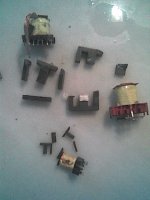Hello,
I'd like to know if there's a way to dismantle the transformer of an ATX computer PSU securely. I suppose that the core halves are glued together by some curing glue and might not fall apart when heat is applied. Is there any other way to separate them without causing destruction?
Best regards!
I'd like to know if there's a way to dismantle the transformer of an ATX computer PSU securely. I suppose that the core halves are glued together by some curing glue and might not fall apart when heat is applied. Is there any other way to separate them without causing destruction?
Best regards!
Try by putting transformer on hot and after some time with force pull apart core.
Maybe you will succed, maybe not, it worth try, doesn't cost anything.
Maybe you will succed, maybe not, it worth try, doesn't cost anything.
A lot of them are assembled with resin glues and varnishes, the only way through that is with a Dremel.
A Dremel will not cut through a Ceramic material, or will destroy it.
Both halves (or E+I) are glued with some kind of Epoxy.
You will not "melt" it but you can soften it enough to separate ferrites, applying some pressure but without cracking them.
Slow and even does the job.
1) chemical: leave transformer inside a covered glass jar or Tupperware type plastic box, submerged in Acetone, Ethyl Acetate, nail enamel remover or good quality paint thinner, if possible overnight, becausen solvent will take some time reaching deep.
2) thermal: boil transformer for at least 30 minutes, then apply even pressure.
Use gloves because core must be very hot , ideally at 100C or nearby, to soften Epoxy.
Some add a couple spoonfuls of salt to water, to slightly rise boiling point beyond 100C.
Not all transformers are the same, a few simply can not be separated.
I)f they were glued with cyanoacrilate instead of epoxy, they are much easier to separate, 100C is deadly to it, while Epoxy stands way more ... in any case it´s weaker at 100C than at room temperature.

Results of impatience:
Both halves (or E+I) are glued with some kind of Epoxy.
You will not "melt" it but you can soften it enough to separate ferrites, applying some pressure but without cracking them.
Slow and even does the job.
1) chemical: leave transformer inside a covered glass jar or Tupperware type plastic box, submerged in Acetone, Ethyl Acetate, nail enamel remover or good quality paint thinner, if possible overnight, becausen solvent will take some time reaching deep.
2) thermal: boil transformer for at least 30 minutes, then apply even pressure.
Use gloves because core must be very hot , ideally at 100C or nearby, to soften Epoxy.
Some add a couple spoonfuls of salt to water, to slightly rise boiling point beyond 100C.
Not all transformers are the same, a few simply can not be separated.
I)f they were glued with cyanoacrilate instead of epoxy, they are much easier to separate, 100C is deadly to it, while Epoxy stands way more ... in any case it´s weaker at 100C than at room temperature.
An externally hosted image should be here but it was not working when we last tested it.
An externally hosted image should be here but it was not working when we last tested it.

Results of impatience:
An externally hosted image should be here but it was not working when we last tested it.
Last edited:
The SMPS I designed a few years ago just had a metal clip holding the two cores together.
It could easliy be taken apart but the fly in the ointment was the number of pins on the transformer soldered to the pcb. A pig to un-solder.
It could easliy be taken apart but the fly in the ointment was the number of pins on the transformer soldered to the pcb. A pig to un-solder.
I used to use a coffee can full of paint stripper. A bath in that for 24 hours would turn the transformer varnish into gel and allow one to ease the cores out of the bobbin without hurting them. It also left nylon bobbins intact, and certainly wouldn't hurt phenolic bobbins. These days, the amount of methylene chloride in paint strippers has declined, so they no longer do the job they used to. The chloroform suggestion would probably work a treat, though I haven't tried it as of yet.
Thanks for your hints so far! Yes, the results in JMFahey's 3rd pic are those I'm used to be getting to date 🙄.
I know of the very good properties of chlorofrom as a solvent, but it is rather hard to obtain here in Germany, due to it's narcotic property 😱.
Best regards!
I know of the very good properties of chlorofrom as a solvent, but it is rather hard to obtain here in Germany, due to it's narcotic property 😱.
Best regards!
If you can get a current to flow in the ferrite it will heat up pretty fast and melt the glue.
There are 2 problems with the method:
1)if the heating is uneven it may break the core and you have to glue it.
2)It takes some pretty high voltages to get a current to flow. As the core heat up the current increases a lot. Thus you want a high voltage (I use 100-150V) and probably also some sort of current limit (maybe 500mA?). A variac and a "bulb-limiter" may work.
Use this method with care! the voltages can kill and the core can get hot enough to burn stuff.
Kind regards TroelsM
There are 2 problems with the method:
1)if the heating is uneven it may break the core and you have to glue it.
2)It takes some pretty high voltages to get a current to flow. As the core heat up the current increases a lot. Thus you want a high voltage (I use 100-150V) and probably also some sort of current limit (maybe 500mA?). A variac and a "bulb-limiter" may work.
Use this method with care! the voltages can kill and the core can get hot enough to burn stuff.
Kind regards TroelsM
Out of interest, why do you want to dismantle a Tx? Is it just to inspect, re-use or separately test the core halves ?I'd like to know if there's a way to dismantle the transformer of an ATX computer PSU securely..... Is there any other way to separate them without causing destruction?
It's either to modify the SMPS for other output voltages or to salvage the core halves.
Best regards!
Best regards!
Have you been able to identify the circuit schematic, and if any secondary windings are on the outermost layers that can be modified/removed, given that there may be multiple secondary windings.
This and this, first one is great, maybe even better than second one, but both work1) chemical: leave transformer inside a covered glass jar or Tupperware type plastic box, submerged in Acetone, Ethyl Acetate, nail enamel remover or good quality paint thinner, if possible overnight, becausen solvent will take some time reaching deep.
2) thermal: boil transformer for at least 30 minutes, then apply even pressure.
And the question after succesfull dismantling it, how to determine the valeu of it for calculating the windings,.
Some toughts to do that easely.
regards
Some toughts to do that easely.
regards
Just design for the same flux density (volts X time product, effectively) as the original, unless you can get other data on the core that says it can take more of a pounding. Maybe not move toooo far off the original design frequency, again, unless you know the core losses won’t skyrocket if you raise F.
If you didn’t count the turns when you dismantled it that’s on you. That’s pretty critical info, unless you have a data sheet in front of you.
If you didn’t count the turns when you dismantled it that’s on you. That’s pretty critical info, unless you have a data sheet in front of you.
- Home
- Amplifiers
- Power Supplies
- How to dismantle a SMPS transformer?


